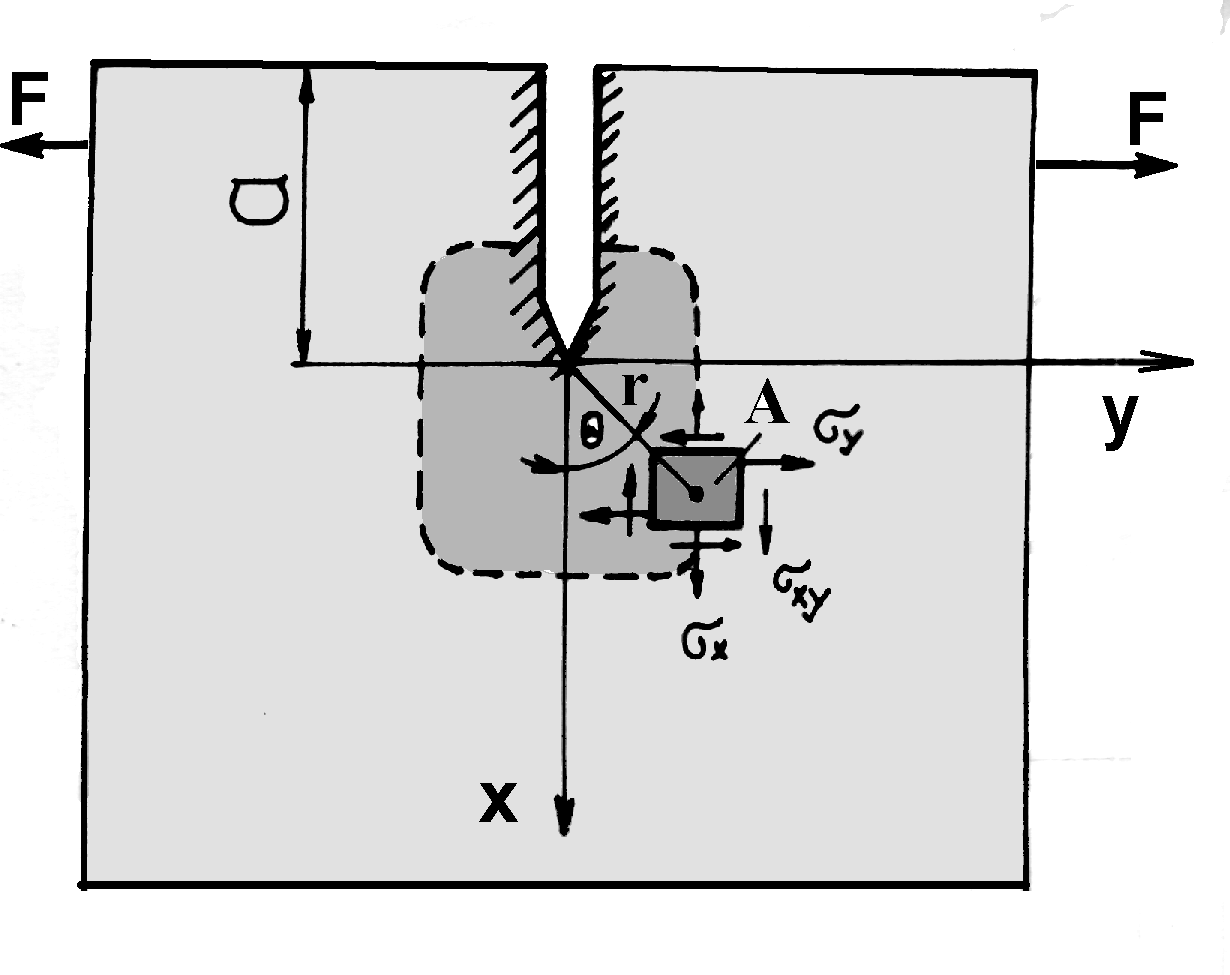Evaluation_Formulae1
3.2.2.1 Evaluation Formulae
The basis of linear refraction mechanics was founded by Irwin (Irwin, 1960) who searched for a method of how to simulate, in laboratory conditions, the real conditions of material usage in a given construction. The solutions he suggested consider linear validity of the Hook law between tension and deformation.
In his model displayed in Fig. 3–27, which has the shape of a very narrow stripe with the crack of length a in it, he studied the state of stress in the crack surrounding.

Fig. 3–27 Model of opening the crack
After reaching a certain depth between the wood fibres the sides of the wedge open the crack while another effect similar to the one observed in the case of opening the crack by traction forces appears in the crack root.
For any point A in the surrounding of the crack root (Fig. 3–27) given by radius r and angle Θ the local tension can be calculated if the conditions of elastic balance and elastic continuity are fulfilled, according to the following equations (Balaš, Szabó, 1986):
 ,(3.48)
,(3.48)
 ,(3.49)
,(3.49)
 ,(3.50)
,(3.50)
In the experimental methods of refraction mechanics, the dominant opinion is that the state of tension around the crack in the plane area of any shape and any loading can be expressed by the solution where only the first members of the equations are taken into consideration (3.48, 3.49 and 3.50) and, after modification we get the following formulae:
 ,(3.51)
,(3.51)
 ,(3.52)
,(3.52)
 .(3.53)
.(3.53)
This is called the singular solution and it represents the basis of practically all present methods of experimental determination of the K – coefficient of the tension intensity.
The analysis of cracks within the linear theory of elasticity is often called the linear elasticity refraction mechanics. Other models tend to take into consideration the non-linear behaviour of the material around the crack tip. It concerns mainly the process of deformation and propagation of the crack in the development zone mainly behind the once opened crack. In the linear elasticity refraction mechanics we assume that the area of energy dissipation is very small in comparison with the dimensions of the real details and, therefore, mathematically it is considered to be a point, i.e. an area of zero size.
We assume that in the case of external loading F = 0 there is zero tension in the body and also zero relative stress (deformation). The potential energy of the given system consisting of the body and the loading is, according to the linear theory of elasticity (Larfen, 1990) expressed as follows:
 ,(3.54)
,(3.54)
where u is the point of loading.
According to the elementary theory the volume of the timber is:
 ,(3.55)
,(3.55)
After substitution of u to the formula (3.54) we obtain the form:
 ,(3.56)
,(3.56)
where E is the modulus of elasticity,
I – cross-sectional moment of inertia
The change of potential energy dW as a result of small development of the crack da is based on the following solution:
 ,(3.57)
,(3.57)
This decrease of
potential energy is adequate to positive release of energy
–dW
and to simultanneous increase of deformation surfaces by bda.
The released energy related to the surface deformation bda is
generally named as G and is calculated as follows:
 ,(3.58)
,(3.58)
where b is the body width.
If load F is so large that the crack starts to propagate, G reaches its critical value Gc. This value corresponds to the material ability to dissipate energy. For European coniferous wood the value Gc, depending on the wood density, is between approximately 150 and 600 J/m2 for deformation by traction perpendicular to the grain. Then the deformation criterion is:
 ,(3.59)
,(3.59)
which gives with the value G from the above formula the following failure load Fc:
 ,(3.60)
,(3.60)
From this formula it results that the carrying capacity is dependent on the body dimensions while the resistance against the crack propagation is dependent on material elasticity modulus E and refraction energy Gc.


